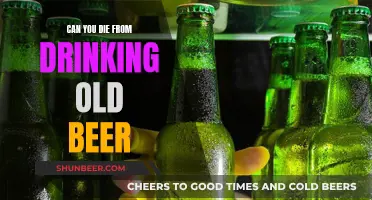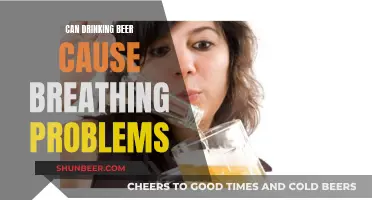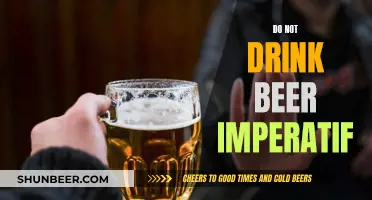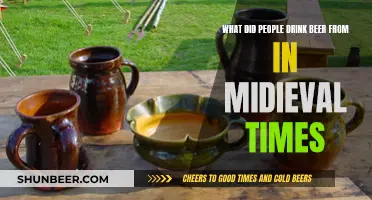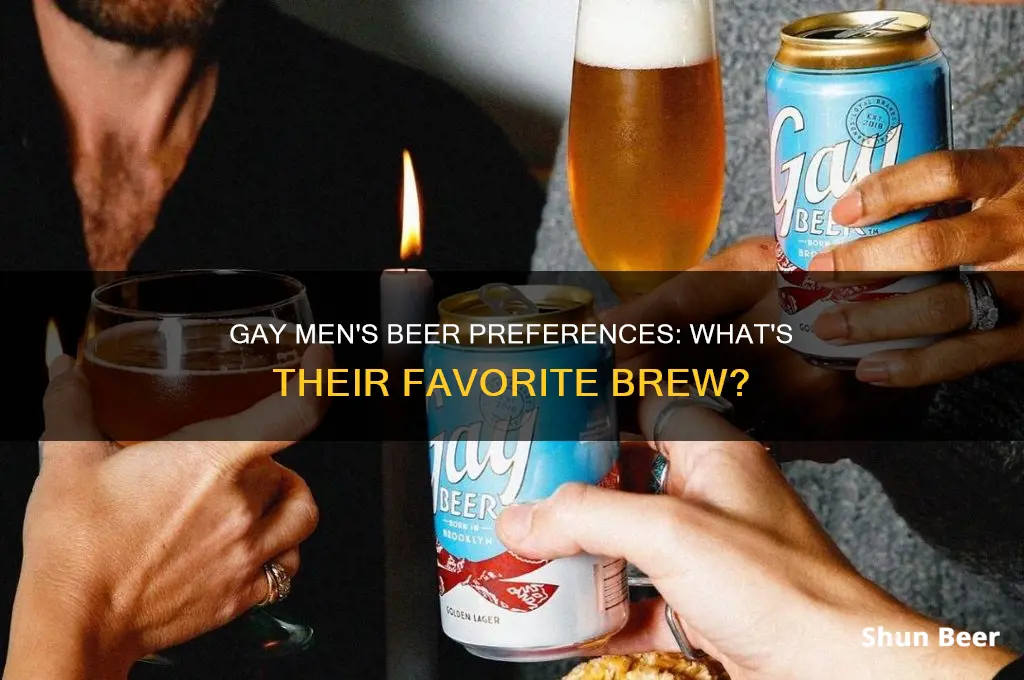
Gay men, like anyone else, drink a variety of beverages. However, societal expectations and marketing tactics have influenced the drinking preferences of gay men, who may feel pressure to order drinks that fit in with the hyper-camp and feminised personas depicted in popular culture. This is particularly true in crowded, non-LGBTQ+ venues, where gay men may feel the need to choose drinks that will not raise eyebrows or attract unwanted attention.
In recent years, there has been a shift towards more diverse and inclusive marketing in the beer industry, with some brands partnering with LGBTQ+ groups or advocates. For example, Budweiser released a special rainbow-coloured bottle for World Pride in 2019, and Miller Lite launched its Open & Proud campaign in 2021. Despite this progress, LGBTQ+ venues built around beer-drinking are still few and far between, particularly outside of large cities.
One example of a beer brand specifically targeting the LGBTQ+ community is Gay Beer, a golden lager with notes of honey and crisp citrus. Its creators, Jason Pazmino and Jon Moore, aim to connect communities of beer lovers and promote inclusivity through their product.
What You'll Learn
- Gay Beer is a real drink, a golden lager with notes of honey and citrus
- Beer marketing has historically targeted a specific type of masculinity, with women portrayed in subservient roles, and LGBTQ+ folks excluded
- LGBTQ+ people may feel pressure to order drinks that fit in with the hyper-camp and feminised personas depicted in popular culture
- Beer companies have been criticised for performative progressivism, only engaging with queer drinkers during Pride Month
- Some LGBTQ+ venues are built around drinking alternatives to beer, like cocktails, cider, and wine

Gay Beer is a real drink, a golden lager with notes of honey and citrus
The founders of Gay Beer, Jason Pazmino and Jon Moore, created the brand to start a conversation and make a connection with diverse consumers. They wanted to pioneer change and inclusivity in the beer market, honouring the rich heritage of the LGBTQ+ community. Gay Beer is currently available for delivery in 45 US states.
While there is no one "gay drink", certain cocktails and beverages are often associated with the LGBTQ+ community and gay culture. For example, during Pride celebrations, it is common to see rainbow-themed cocktails or drinks with colourful garnishes. Vodka Cranberry, The Cosmo, and Appletini are some of the popular cocktails associated with the gay community.
In recent years, major beer brands have also shown their support for the LGBTQ+ community through sponsorships and partnerships. For instance, Coors Light has sponsored Denver PrideFest and supported LGBTQ+ facilities, while Budweiser has released rainbow-coloured bottles during World Pride and sponsored Pride events in London and Toronto. These initiatives reflect a growing trend towards inclusivity and representation in the beverage industry, challenging stereotypes and creating a more welcoming environment for all drinkers.
American Soldiers' WWI Beer of Choice
You may want to see also

Beer marketing has historically targeted a specific type of masculinity, with women portrayed in subservient roles, and LGBTQ+ folks excluded
Beer marketing has long been associated with a specific type of masculinity, often portraying women as subservient and excluding LGBTQ+ individuals. This approach has contributed to the perception of beer as a "male drink," alienating a significant portion of potential consumers.
Historically, beer advertisements have frequently featured all-male casts or objectified women as subjects of desire, reinforcing gender stereotypes and contributing to a macho culture. This exclusionary marketing strategy has not only been detrimental to the industry by limiting its appeal but has also had a negative impact on the self-confidence of women and LGBTQ+ individuals.
While there have been some efforts to address this issue, such as Budweiser's decision to revisit and modernize its sexist ads from the 1950s and 1960s, much of the sector's famous advertising continues to be geared towards men. This is despite the fact that women have a long history of brewing and have enjoyed beer alongside men worldwide.
To make beer more inclusive, marketers need to recognize that women do, in fact, drink beer and that their purchasing decisions are influenced by how they are portrayed in advertising. By featuring diverse and empowering representations of women and LGBTQ+ individuals in their campaigns, beer companies can move towards more progressive and inspirational marketing that appeals to a wider audience.
Additionally, it is important to promote different styles, varieties, and sizes of beer to cater to varying tastes and preferences. Beer companies also have a responsibility to ensure that women and LGBTQ+ individuals are represented at all levels of their organizations and are included in decision-making processes. By embracing diverse opinions and experiences and challenging non-inclusive macho behavior, the industry can create a more welcoming and equitable environment for all.
The Best Beer Choices of Costa Ricans
You may want to see also

LGBTQ+ people may feel pressure to order drinks that fit in with the hyper-camp and feminised personas depicted in popular culture
The drinking preferences of LGBTQ+ people are influenced by a variety of factors, including societal expectations, peer pressure, and the need to conform to specific gender norms. While some LGBTQ+ individuals may feel comfortable ordering any drink of their choice, others may feel pressured to conform to certain stereotypes or avoid potential discrimination.
In crowded, non-LGBTQ+ venues, LGBTQ+ people may feel pressured to order drinks that align with societal expectations and stereotypes. For gay men, this could mean choosing drinks that reinforce hyper-camp and feminised personas often depicted in popular culture. This may include cocktails like Vodka Cranberry, The Cosmo, or Appletini, which are sometimes perceived as "chick drinks" or more feminine options. On the other hand, lesbians might opt for a pint of ale, preferably dark and strong, to align with the stereotype of masculine drinks.
The pressure to conform to these drink choices is influenced by the dominant culture of heterosexual peers and the desire to "fall in line" and "raise no eyebrows." Additionally, there is a genuine concern for personal safety, especially in environments that may not be LGBTQ+-friendly. Ordering drinks that deviate from these expectations can lead to unwanted attention, taunts, or even harassment.
The influence of "lad culture" further exacerbates this pressure. Lad culture, as described by Eva Wiseman, promotes a specific type of masculinity that involves hard drinking, bantering, and normalising sexual harassment. This culture is prevalent in many drinking spaces and can be intimidating for gay men, who may feel the need to pass as straight to avoid negative reactions or discrimination.
However, it's important to note that not all LGBTQ+ people conform to these drink choices. Some may actively challenge stereotypes by ordering drinks that society doesn't typically associate with their gender or sexual orientation. Additionally, the increasing diversity in drinking options, such as craft beers, allows individuals to explore and express their tastes more freely.
The beer market is also evolving to become more inclusive. Brands like "Gay Beer" aim to pioneer change and inclusivity in the beer market by celebrating the connections made through sharing a beer within the LGBTQ+ community. Additionally, some major beer companies have partnered with LGBTQ+ groups or sponsored LGBTQ+ events, although these efforts have sometimes led to backlash and boycotts from conservative groups.
Drinking Two Beers: Worth the Buzz or Not?
You may want to see also

Beer companies have been criticised for performative progressivism, only engaging with queer drinkers during Pride Month
Beer companies have been criticised for performative progressivism, engaging with queer drinkers only during Pride Month. This phenomenon, known as "rainbow-washing", involves brands using performative activism for commercial gain without taking any further action to demonstrate their support for the LGBTQIA+ community. While creating rainbow versions of logos and releasing Pride-themed product lines might seem positive, they can be perceived as disingenuous if not backed up by concrete and meaningful actions.
For example, a survey by Reboot in 2021 revealed that a third of companies that created Pride marketing campaigns did not donate any profits to LGBTQIA+ organisations. This indicates that their support was only superficial and did not translate into tangible benefits for the community. Consumers are becoming increasingly aware of these tactics and are demanding more from brands. According to a survey by Small Business Trends, 83% of Millennials said they purchase from companies that align with their beliefs, and 62% believe buying from companies that support their political and social beliefs is important.
To avoid accusations of rainbow-washing, companies should demonstrate a long-lasting commitment to supporting the LGBTQIA+ community, not just during Pride Month. This can be done by donating to LGBTQIA+ charities, highlighting local activists or organisations, and ensuring their own Diversity, Equity, and Inclusion (DEI) efforts are inclusive of LGBTQIA+ employees. Normalisation, rather than stereotyping, is key. Brands should include LGBTQIA+ individuals in their marketing campaigns and ensure that their voices and experiences are central.
Some beer companies have made efforts to engage with the LGBTQIA+ community beyond Pride Month. For instance, Coors Light has been sponsoring the Denver PrideFest and supporting the Center on Colfax, an LGBTQ+ facility in the city. Budweiser has sponsored London Pride and Toronto Pride and released a rainbow-coloured bottle to raise money for GLAAD. Miller Lite has also donated $450,000 to the Equality Federation and launched its "Open & Proud" campaign to promote inclusivity in bars. These efforts demonstrate a more authentic commitment to supporting the LGBTQIA+ community, rather than just engaging with queer drinkers during Pride Month.
However, even these efforts can be seen as tokenistic if they are not part of a broader strategy to address the issues facing the LGBTQIA+ community. It is important for companies to understand the history of LGBTQIA+ rights and the ongoing struggles faced by the community. This includes acknowledging the impact of issues such as conversion therapy, anti-trans legislation, and discrimination in bars and workplaces. By addressing these issues and taking meaningful action, beer companies can move beyond performative progressivism and demonstrate a genuine commitment to inclusivity and diversity.
Girls and Beer: How Much is Too Much?
You may want to see also

Some LGBTQ+ venues are built around drinking alternatives to beer, like cocktails, cider, and wine
While beer is a popular drink within the LGBTQ+ community, some LGBTQ+ venues are built around drinking alternatives, such as cocktails, cider, and wine. These venues offer a range of drinks that cater to diverse tastes and preferences. For those who enjoy cocktails, there are numerous options available, including the classic Cosmopolitan, the Appletini, and the Vodka Cranberry. These drinks are often associated with the bar-going gay community and are commonly served at Pride celebrations. Additionally, craft cocktails, such as those made with local small-batch spirits, inventive bitters, homemade syrups, and freshly squeezed citrus, are becoming increasingly popular within the LGBTQ+ community.
For those who prefer cider, there are also several LGBTQ+-friendly venues that specialise in this drink. Craft cider, in particular, has gained traction within the community, offering a refreshing alternative to beer. Similarly, wine is another popular choice, with LGBTQ+ venues serving everything from sparkling rosé to white wine and Pinot Gris. These venues often elevate the wine-drinking experience by pairing it with creative mixers, such as sparkling lemonade or elderflower liqueur.
The LGBTQ+ community has a rich history of enjoying cocktails, which has become an integral part of queer culture. These drinks are not only a means of celebration and socialising but also hold significant symbolic value. Many cocktails are named after queer icons or events, such as the Harvey Milkshake or the Stonewall Sour, honouring the people and moments that have shaped the community's history. Additionally, cocktails within the LGBTQ+ community are often brightly coloured, garnished with rainbow sprinkles or edible glitter, and served in elaborate glassware, adding to the festive and expressive nature of these venues.
Whether it's a cocktail bar, a cider house, or a wine lounge, these LGBTQ+ venues provide a space for community building, socialising, and celebration. They offer a diverse range of drinks that cater to different tastes and preferences, ensuring that everyone can find something to enjoy. So, whether you're toasting to love and acceptance or simply unwinding after a long day, these venues provide a welcoming and inclusive atmosphere.
Beer and Aligners: What You Need to Know
You may want to see also
Frequently asked questions
Gay men drink a variety of beers, just like anyone else. However, some popular beer brands among gay men include Budweiser, Coors Light, Miller Lite, and Bud Light, which has been endorsed by transgender influencer Dylan Mulvaney. There is also a craft beer called Gay Beer, which is a golden lager with notes of honey and crisp citrus.
Gay men, like anyone else, may drink beer to unwind, socialise, or celebrate. Beer is often associated with special occasions and social gatherings, and it can be a way for people to connect and build community.
While there is no definitive "gay drink," certain cocktails and beverages are sometimes associated with the LGBTQ+ community or considered "gay drinks" by some people. These include cocktails like Cosmos, Margaritas, Appletinis, and Vodka Cranberry, as well as lighter beers, ciders, and wine coolers. However, these associations are often based on stereotypes, and there is no one-size-fits-all drink choice for gay men.
The beer industry has a history of targeting a specific type of masculinity in its advertising, with male-dominated ads and sports sponsorships. However, in recent years, some beer companies have made efforts to be more inclusive of the LGBTQ+ community. For example, during Pride Month, you may see limited-edition rainbow branding and campaigns celebrating diversity. Additionally, some beer companies have sponsored LGBTQ+ events and partnered with LGBTQ+ groups or advocates.


